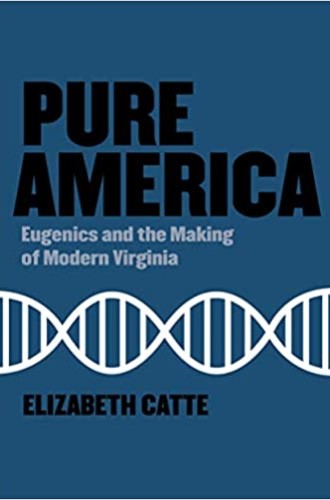A landscape scarred by the trauma of eugenics
Elizabeth Catte traces the haunting history of forced sterilizations in Central Virginia.
Law school curricula do not typically feature the Supreme Court’s 1927 decision in Buck v. Bell, which upheld the Virginia Sterilization Act of 1924 from a constitutional challenge and permitted state health superintendents to force sterilization upon patients. Its brief mention in the constitutional law class I took as a first-year law student at the University of Virginia identified it only in contrast with subsequent cases protecting individual rights like the right to privacy.
Writing for an 8–1 majority, Justice Oliver Wendell Holmes Jr. clothed utilitarianism with bigotry by stating that “it is better for all the world, if instead of waiting to execute degenerate offspring for crime, or to let them starve for their imbecility, society can prevent those who are manifestly unfit from continuing their kind.” He concluded with some of the most haunting—and, yes, evil—words to be published in a Supreme Court opinion: “Three generations of imbeciles are enough.”
Read our latest issue or browse back issues.
It is hard to read these dehumanizing words, which rationalized the forced sterilization of more than 7,000 people in Virginia and approximately 70,000 nationwide. Elizabeth Catte, in a “Note on Language and Content” that serves as a preface to Pure America, writes that this “ugly and abusive language that historical actors invented to describe people perceived to have disabilities in the past” is part of the “long history in America of imprinting racial, gender, and class prejudices onto the concept of disability.” These prejudices were built on fear of losing privilege and power. Rearticulated in a scientific and therefore “modern” veneer, they glamorized Nordic stock and pathologized those who lacked power.
Catte unpacks this history by placing it on specific plots of land and introducing us to the human beings who populated that land. In doing so, she seeks to understand the world that the eugenicists “actually made and how it lives on in the present.”
We travel with Catte to Charlottesville, Carrie Buck’s hometown, and learn that she was raped by her foster parents’ nephew when she was 17. After Carrie was institutionalized by her foster parents, the state used her case to test the validity of the Sterilization Act. Her defense attorney, appointed by the sterilization board established by the act, was a former sterilization board member and eugenics advocate whose arguments during the trial were “not meant to be a true appeal, but more a legally binding theatrical performance.”
Carrie was sterilized in October 1927, a few months after the Supreme Court decision. But we also learn that she “survived, and her life was long” and filled with marriage, “little gardens, pigs, and reunions with siblings she thought she had lost.” One sibling, a younger sister named Doris Figgins, lived for decades with the sadness of “feeling she failed because she couldn’t have children.” Doris was unaware until the late 1970s that she had been sterilized without her consent.
After telling the story of Carrie and her family, Catte takes us to Shenandoah National Park, which is nestled in the mountains west of Charlottesville. There we learn that the park’s local boosters intentionally misrepresented to federal authorities the number of mountain families that would be displaced through the power of eminent domain. This forced removal led some residents to be institutionalized in the same state hospitals where Carrie Buck, Doris Figgins, and thousands of others were taken and, in some cases, forced into involuntary servitude to pay for their stay.
Finally, Catte takes us to Western State Hospital in her hometown of Staunton, Virginia, which was the site of about 1,700 forced sterilizations between 1927 and 1964. In recent years, Western State has been transformed by a developer (with the help of tax credits) to become a luxury hotel and condominium complex. While the promotional materials for the new development detail the architectural significance and early history of Western State during the 19th century as a sanitorium and place of rehabilitation, that history skips about a hundred years, ignoring the site’s involvement in the eugenics movement and the people it victimized.
This is a common choice in the narratives around historic preservation, Catte explains, likening Western State’s owners to the owners of former southern plantations, who “justify their interpretive choices” to de-emphasize slavery “by arguing that the history of enslavement can be found in other places, including academic scholarship.” These narrative choices are, Catte suggests, “an intentional strategy to prevent us from getting to the what, which would mean identifying these historical properties not just as architectural monuments, but as sites of trauma.”
Catte’s interpretive framework is not new; she acknowledges and quotes Michel-Rolph Trouillot, a Haitian historian and author whose Silencing the Past: Power and the Production of History identified a struggle for power in the narratives we tell in our places and about ourselves. Throughout Pure America, Catte deftly locates these past and present struggles for power at the sites of trauma. Indeed, given the importance of place to Catte’s narrative, my biggest criticism of the book is its lack of a map, which would have given readers additional context.
Nonetheless, this quibble is minor; Catte weaves a haunting but necessary story of how eugenics shaped and continues to shape her community, as well as how eager some in the community are to move on and forget. By focusing on how the landscape of central Virginia and the Shenandoah Valley still displays scars of trauma, Catte shows the need for communities across the country to confront the present narratives that shape our understanding of the past. I won’t look at the built environment around me—wherever I find myself—in the same way.
A version of this article appears in the print edition under the title “Sites of trauma.”







